Frank Lloyd Wright -- The Woodblock Print Collector
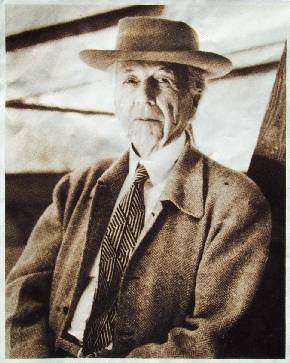
Frank Lloyd Wright (1867-1959)
Beyond the Architect
Without a doubt, the name "Frank Lloyd Wright" is certainly the most well known of all American architects. As the public is well aware, by reputation Wright has justifiably and forever established himself as the preeminent designer of boldly creative, new architectural designs.
However, only recently it seems has Wright’s deep, personal OBSESSION for Japanese woodblocks been fully revealed. Details of this fascinating story about Wright’s lifelong association with Japanese prints is detailed in the recently released book by Julia Meech titled “Frank Lloyd Wright and the Art of Japan – The Architect’s Other Passion,” which begins with the words “This is the untold story of the role played by Frank Lloyd Wright (1867-1959) in the world of Asian art connoisseurs. It is the story of Wright’s other passion….”
Through Meech’s book we learn, often in Wright’s own words, the tremendous impact Japanese prints had on not only Wright’s designs, but also his entire life: “I remember when I first met the Japanese prints. That art had a great influence on my feeling and thinking…..I began to see nature in a totally different way.” Later in life, Wright further wrote, “If Japanese prints were to be deducted from my education, I don’t know what direction the whole (of my life) might have taken.”
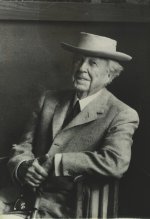
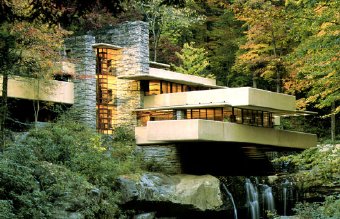
Architect Wright and Wright's Famous "Falling Water" House
In reading Meech’s account of Wright’s life, it is immediately apparent to this author what a complete and TOTAL force Japanese prints apparently held over nearly all of Wright’s activities and thinking. Yes, he was indeed an architect—but it seems quite likely that much of his activities and energy centered about and were derived from his intimate love of Japanese art.
How the Quest Began
Wright’s first “exposure” to Japanese prints appears to have been the January 1896 Exhibition and sale of over 440 ukiyo-e prints by the collector Ernest Fenollosa which was held in New York. Of this Exhibition, Wright later in 1917 wrote: “When I first saw a fine print (Japanese woodblock) about twenty-five years ago, it was an intoxicating thing.” As a result, it was then during this same late-1890’s time period that various pieces of Japanese woodblocks and other art began to be seen in early, dated photographs of both Wright’s home and office. Wright had clearly been smitten by Japanese prints, and appears to have immediately begun to collect them with a newfound passion. Also at the same time, various shadowings of the “design influence” of Japanese prints began to show up in Wright’s work as well, with the tall/narrow design shapes of vertical Japanese “pillar prints” (“hashira-e”) and hanging scrolls (‘kakemono”) becoming frequently incorporated into Wright’s architectural designs
Wright’s “Collection” and “Print Viewing Parties”
Wright’s passion towards Japanese art soon grew to the point where it became an ever-present obsession. As a result, Wright literally surrounded himself with Japanese art, as it was found throughout, and in every nook and cranny, of his home and offices. Japanese prints decorated many of his walls, and it is well known that Wright kept within his bedroom/office a specially built easel upon which he always kept a changing display of three woodblock prints for ready viewing. His was also known for his tireless arranging and rearranging of prints and art objects throughout his home.
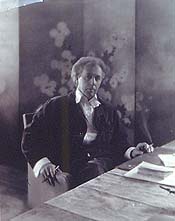
Wright seen seated before a Japanese Screen
When Wright spoke of his “Collection,” he was known to be speaking primarily of his large woodblock print inventory—however his collection, of course, also included many other examples of Japanese art. Wright seemingly was emotionally attached to many of the prints in his personal collection, and being a passionate and obsessive collector, he hated under any circumstances to part with many of his finer prints.
Wright further understood the educational value of prints, and was among his friends and colleagues well known for the “print viewing parties” which he frequently and eagerly hosted at his “Taliesin” residence/office. At such gatherings, Wright clearly enjoyed telling the history of and describing in detail each of perhaps a dozen or so prints during such an evening event, and was further often known to give away such prints on special occasions as gifts or as work incentives to his employees.
Evidence of An “Intoxicatingly Powerful Grip”
To illustrate the increasingly powerful intoxicating grip that Japanese woodblocks would soon hold over Wright, there is told the story of a 1905 visit which Wright paid to his cousin’s New York office, where he then asked to borrow money for the train fare back to Chicago. Agreeing to help him out, this cousin gave Wright the needed money and saw him off. This cousin was then shocked to discover only an hour later that Wright had returned once again asking for train fare—while in his hands he held a beautiful Japanese woodblock that he had just bought!! (Again, this author can personally relate to this same “mis-adventure”—-having re-committed Wright’s "sin" of nearly a century earlier during a mid 1990’s vacation outing in Kyoto, Japan....)
Wright’s First Trip to Japan
It was about the time of Wright’s first trip to Japan in 1905 (apparently intended purely as a vacation), that Wright began to somewhat “accidentally if not unintentionally” slowly enter the realm of becoming a dealer of Japanese prints. (In the mind of this author, there is no doubt that many woodblock enthusiasts naturally “navigate” over time towards “becoming an art dealer,” simply as a means of immersing themselves into a closer and more intimate association with the art with which they so dearly love.) During this first venture into Japan, Wright is known to have invested heavily into both woodblocks and other forms of art to be used in the decoration of their home. From this first trip alone, Wright is known to have returned with “several hundred Hiroshige woodcuts.” Additional details of Wright’s first three-month trip to Japan with his wife Catherine are well documented in the 1996 book, “Frank Lloyd Wright’s ‘Fifty Views of Japan’ – The 1905 Photo Album.”
Wright’s Second and Subsequent Trips to Japan—Returning As an “Art Dealer”
Returning to Japan in the spring of 1913, it was clear this time that Wright’s intentions were to spend the full 2-month period solely in the earnest pursuit of Japanese woodblocks. Toward this end, by all accounts this trip (aided by his new friend Shugio Hiromichi whom he’d apparently met earlier in Chicago) was widely successful. With connections made by Shugio, “word of Wright’s business in Japan” spread rapidly. As Wright later wrote of this trip, “Already I had established a considerable buying power and anything available in the ordinary channels came first to me. I picked up some fine things this way….(Soon) the twenty thousand dollars was gone…(so)…I would cable (to the Spauldings) for money from time to time….until I had spent about one hundred and twenty-five thousand Spaulding dollars for about a million dollars’ worth of prints.”
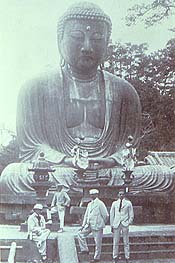
Wright (far left) at "Great Buddha" at Kamakura, Japan (1921)
Wright’s significant move into the active buying and selling of Japanese prints further accelerated during the 1917 to 1922 period, when he spent a considerable amount of time in Japan with the design and construction of his world famous Tokyo “Imperial Hotel.”
During this period, Wright “let it be known” to the Japanese public that he was actively seeking to purchase works of Japanese art. At the same time, many of America’s largest woodblock print collectors from the Midwest and East coast (such as the Spauldings, Van Vleck, Mansfield, Ficke, among others), also learned of Wright’s trips to Japan, and thusly commissioned him as their “agent” to seek out prints for their own collections.
(Wright's "Imperial Hotel" (pictured below), which survived both the 1923 Great Tokyo Earthquake as well
as the devastating bombings of Tokyo during world War II, was demolished in 1968
and replaced by the currently in use Third Imperial Hotel.)
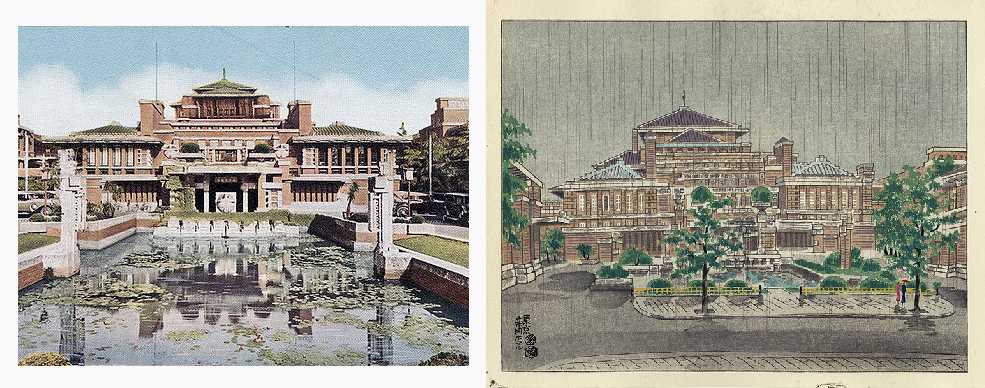
Postcard view (1930's) and Eiichi KOTOZUKA "Imperial Hotel in Tokyo" print (ca1950)
Speaking later of his significant time spent in Tokyo during the construction of the “Imperial Hotel” (of the 1917-22 period, Wright spent an amazing 37 cumulative months in Japan), Wright later wrote “The pursuit of the Japanese print became my constant recreation while in Tokio….The adventures and excursions would take place at night or sometimes call for a journey by day to distant places in search of them. Endless the fascination of the quest.” During this period spent in Japan, Wright’s reputation as a “buyer of prints” grew to the point where he was actually able at times to simply “sit back” and let the Japanese print dealers come to him.
Falling Upon Hard Times....
Due in large part to the obsessively powerful grip which Japanese prints held on Wright’s life, we learn that much of Wright’s entire life was lived far beyond his means as an initially only modestly successful architect. To this point, he even took as his “personal motto”—and seemingly adopted as a lifestyle—the words of Oscar Wilde: “Let me have the luxuries and the necessities will take care of themselves.” As a result, the architect Wright often found himself to be seriously in debt, and was even known to have at times to have used his beloved Japanese prints as collateral.
During some of the lean years of Wright’s early architectural career, records indicate Wright--lacking hard cash—even used Japanese artworks which he bartered in exchange for food and needed supplies. At other times, he even handed out Japanese prints to his architectural staff in lieu of their salaries.
Sadly, later in his life, Wright repeatedly fell upon hard financial times and was thusly forced on several occasions to part with significant portions of his beloved “Collection” to pay off debts and obligations. Being collectors of Japanese prints ourselves, it is not difficult to imagine the considerable emotional pain this must have inflicted upon this once proud collector.
Nevertheless, despite all of Wright’s on-going financial hardships, at the time of his death in 1959 (at the age of 92) there still remained some 6,000 prints in his diminished “Collection.” Nearly all of these prints were then sold off by his surviving widow during the following decade of the 1960’s.
Wright’s “Surimono” Collection
Finally, with all of Wright’s remaining collection thought to have been sold off to cover past-due taxes and other debts, some 27 years after Wright’s death there remained an exciting discovery. In the winter of 1986, a staff member of the Frank Lloyd Wright Archives group lifted a simple Japanese wooden box down from a storage shelf and discovered it to contain a group of over 650 fine Japanese “surimono” prints. This final remaining, intact portion of Wright’s “Collection” is detailed in yet another recent book, “The Frank Lloyd Wright Collection of Surimono,” which details over 320 of these rare prints.
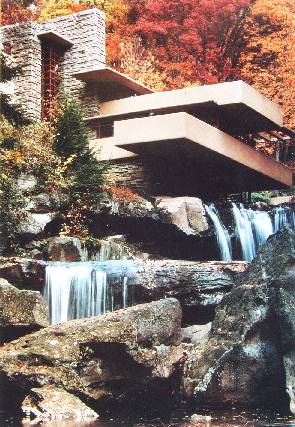
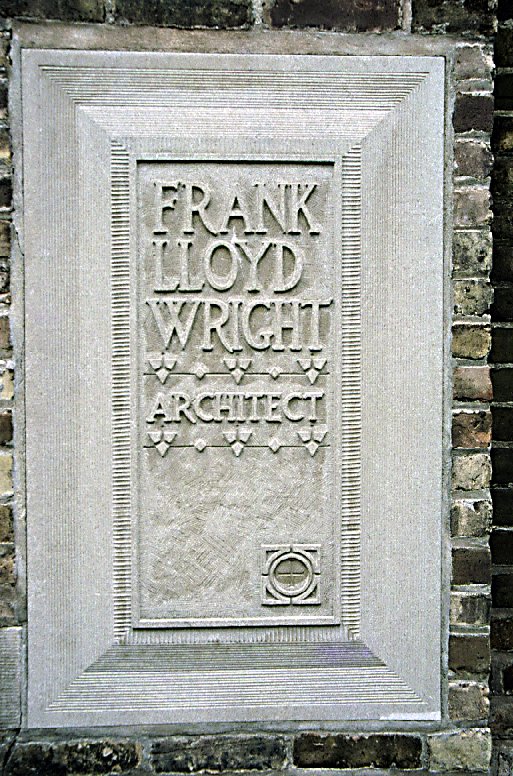
Another View of "Falling Water" and Frank Lloyd Wright Remembered
In the end, just how many woodblocks Wright actually brought to America, of course, remains unknown. However, a very conservative estimate is that at least 20,000 prints were known to have found their way directly into the hands of various American collectors through the efforts of Wright—with prints documented to be of Wright’s provenance found today in many of the finest western collections. In total, however, it seems likely that a number much larger than 20,000 prints is probably closer to the truth.
Bigger perhaps in death than in life, architect Frank Lloyd Wright has without doubt become a lasting American legend.
Only recently, however, are we publicly learning of what was most certainly Wright’s true passion in life: Japanese woodblock prints.
Literature sources used in preparation of this article include:
“Frank Lloyd Wright and the Art of Japan – The Architect’s Other Passion,” Julia Meech, Harry N. Abrams Publisher, New York, 2001, ISBN 0-8109-4563-0
“Frank Lloyd Wright’s ‘Fifty Views of Japan’ – The 1905 Photo Album,” Melanie Birk, Pomegranate Artbooks, San Francisco, 1996, ISBN 0-7649-0003-x
“The Frank Lloyd Wright Collection of Surimono,” Joan B. Mirviss, Weatherhill Publisher & Phoenix Art Museum, 1995, ISBN 0-8348-0327-5
(c) Thomas Crossland and Dr. Andreas Grund, March 2003, Updated June 2012
Gallery
Terms
Ordering
About Us
We Buy Prints
Library

Free counters provided by Andale.








